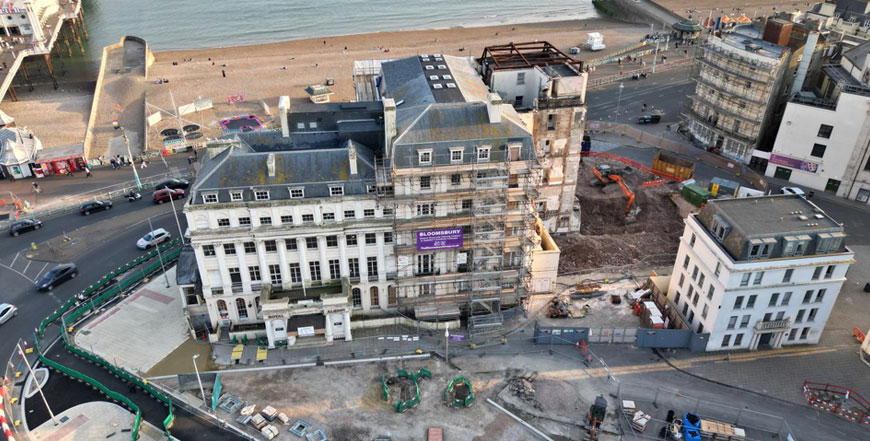The Royal Albion Hotel has long stood as one of Brighton’s most iconic landmarks — a Grade II listed building with over 200 years of history. Severely damaged by fire in July 2023, its future looked uncertain. But thanks to the coordinated efforts of Bloomsbury Surveyors and our sister company The Bloomsbury Group, this historic seafront building is now on the path to full restoration.
As principal contractor and lead surveyors, we’ve taken on the challenge of restoring the Royal Albion not just to its former glory, but with renewed structural integrity and safety throughout. Our work began within days of the fire — and from emergency response through to long-term planning and construction, our combined teams have been involved in every step.
Emergency Response and Initial Assessment
Within 48 hours of the fire, Bloomsbury Surveyors were appointed to carry out an initial risk assessment of the damaged site. Working alongside local authorities and emergency services, our immediate priority was safety — securing the structure, assessing hazards, and identifying sections at risk of collapse.
At the same time, The Bloomsbury Group mobilised rapidly, delivering CDM-compliant site setup, installing perimeter fencing, and putting strict health and safety controls in place to protect the public and nearby businesses.
Detailed Surveys and Damage Reports
Our surveying team undertook an extensive programme of measured surveys, fire damage assessments, and structural monitoring to inform the rebuild strategy. These reports formed the foundation of the planning process, allowing for a detailed restoration roadmap that honoured the hotel’s heritage status while meeting all modern building regulations.
Using drone surveys, 3D scanning, and traditional building pathology, we recorded everything from charred timbers and collapsed stairwells to hidden water ingress points and compromised load-bearing walls.
Design Team Coordination
As the scope of the rebuild became clear, we led the appointment of a specialist design team — bringing in conservation architects, structural engineers, heritage consultants, and planning advisors. Bloomsbury Surveyors acted as the central liaison, overseeing collaboration between stakeholders and ensuring that all proposals respected the building’s listed status.
Our experience with complex heritage buildings proved vital here. We worked closely with Brighton & Hove City Council and Historic England to ensure that the planned works met all necessary conservation requirements.
Demolition and Enabling Works
With the design framework approved, The Bloomsbury Group commenced controlled demolition of unstable sections of the building. This involved carefully removing upper floors and unsafe roof areas, while preserving the historic facade and key architectural features.
Enabling works included the excavation of damaged cellars, temporary propping and shoring of the internal structure, and preparation for asbestos removal. Throughout this phase, our surveying team remained on site to monitor movement, advise on sequencing, and mitigate risks as new issues emerged.
Asbestos Removal and Fire Remediation
As with many older buildings, asbestos was a significant concern. Working with licensed contractors, The Bloomsbury Group completed a full asbestos strip-out under strict HSE guidelines. Our surveyors conducted regular inspections, air monitoring, and clearance testing to ensure the site remained compliant at every stage.
Alongside this, we oversaw a thorough programme of fire remediation works — from the removal of smoke-damaged materials and mould treatment to structural drying and cleaning.
Heritage Roof and Window Reinstatement
One of the most complex tasks has been the reinstatement of the heritage roofing and timber sash windows. These elements are not only key to the building’s character but also essential in ensuring compliance with conservation standards.
Bloomsbury Surveyors worked with joinery specialists to commission custom-made timber windows to match the original Georgian style. The Bloomsbury Group’s craftsmen are now rebuilding sections of the slate-tiled roof, incorporating modern insulation and waterproofing layers while maintaining the building’s authentic appearance.
Ongoing Project Management and Collaboration
This project is a perfect example of what can be achieved through integrated delivery. The Bloomsbury Group has brought its construction expertise to bear on every phase of the rebuild, while Bloomsbury Surveyors have ensured that quality, compliance, and conservation have remained central.
From tender evaluations and cost consultancy to contract administration and stakeholder reporting, we’ve taken a hands-on approach throughout. This includes regular client updates, timeline tracking, and public engagement through the Royal Albion Hotel Timeline, which documents each milestone in the project.
Looking Ahead
The restoration of the Royal Albion Hotel is still ongoing, with major construction phases continuing through 2025. As we rebuild one of Brighton’s most cherished hotels, our commitment remains unchanged: to deliver a building that honours its past, serves the community, and stands proudly on the seafront for generations to come.
Together, Bloomsbury Surveyors and The Bloomsbury Group are not just restoring bricks and mortar — we’re preserving a piece of Brighton’s identity.
Want to follow the progress?
Keep an eye on our live project updates and timeline here:







